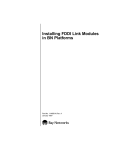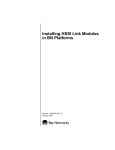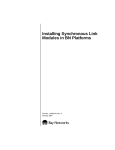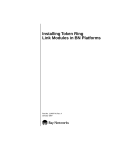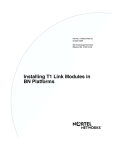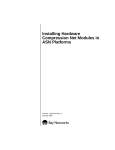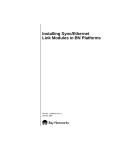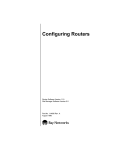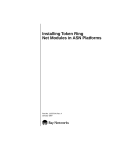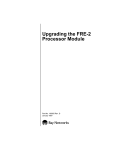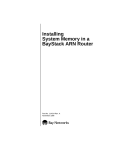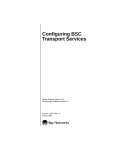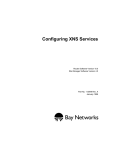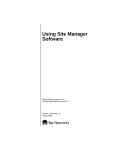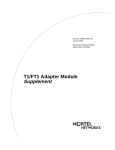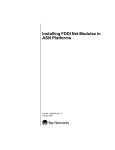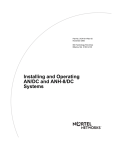Download Avaya Sync/Token Ring Link Modules in BN Platforms User's Manual
Transcript
Installing Sync/Token Ring Link Modules in BN Platforms Part No. 114949-A Rev. A January 1997 4401 Great America Parkway Santa Clara, CA 95054 8 Federal Street Billerica, MA 01821 Copyright © 1988–1997 Bay Networks, Inc. All rights reserved. Printed in the USA. January 1997. The information in this document is subject to change without notice. The statements, configurations, technical data, and recommendations in this document are believed to be accurate and reliable, but are presented without express or implied warranty. Users must take full responsibility for their applications of any products specified in this document. The information in this document is proprietary to Bay Networks, Inc. The software described in this document is furnished under a license agreement and may only be used in accordance with the terms of that license. A summary of the Software License is included in this document. Restricted Rights Legend Use, duplication, or disclosure by the United States Government is subject to restrictions as set forth in subparagraph (c)(1)(ii) of the Rights in Technical Data and Computer Software clause at DFARS 252.227-7013. Notice for All Other Executive Agencies Notwithstanding any other license agreement that may pertain to, or accompany the delivery of, this computer software, the rights of the United States Government regarding its use, reproduction, and disclosure are as set forth in the Commercial Computer Software-Restricted Rights clause at FAR 52.227-19. Trademarks of Bay Networks, Inc. ACE, AFN, AN, BCN, BLN, BN, BNX, CN, FN, FRE, GAME, LN, Optivity, PPX, SynOptics, SynOptics Communications, Wellfleet and the Wellfleet logo are registered trademarks and ANH, ASN, Bay•SIS, BayStack, BCNX, BLNX, EZ Install, EZ Internetwork, EZ LAN, PathMan, PhonePlus, Quick2Config, RouterMan, SPEX, Bay Networks, Bay Networks Press, the Bay Networks logo and the SynOptics logo are trademarks of Bay Networks, Inc. Third-Party Trademarks All other trademarks and registered trademarks are the property of their respective owners. Statement of Conditions In the interest of improving internal design, operational function, and/or reliability, Bay Networks, Inc. reserves the right to make changes to the products described in this document without notice. Bay Networks, Inc. does not assume any liability that may occur due to the use or application of the product(s) or circuit layout(s) described herein. Portions of the code in this software product are Copyright © 1988, Regents of the University of California. All rights reserved. Redistribution and use in source and binary forms of such portions are permitted, provided that the above copyright notice and this paragraph are duplicated in all such forms and that any documentation, advertising materials, and other materials related to such distribution and use acknowledge that such portions of the software were developed by the University of California, Berkeley. The name of the University may not be used to endorse or promote products derived from such portions of the software without specific prior written permission. SUCH PORTIONS OF THE SOFTWARE ARE PROVIDED “AS IS” AND WITHOUT ANY EXPRESS OR IMPLIED WARRANTIES, INCLUDING, WITHOUT LIMITATION, THE IMPLIED WARRANTIES OF MERCHANTABILITY AND FITNESS FOR A PARTICULAR PURPOSE. In addition, the program and information contained herein are licensed only pursuant to a license agreement that contains restrictions on use and disclosure (that may incorporate by reference certain limitations and notices imposed by third parties). ii 114949-A Rev. A Electromagnetic Emissions Meets requirements of: FCC Part 15, Class A EN 55 022 (CISPR 22:1985), Class A <and Class B> VCCI Class 1 ITE Canada Requirements Only Canada CS-03 Rules and Regulations Note: The Canadian Department of Communications label identifies certified equipment. The certification means that the equipment meets certain telecommunications network protective operations and safety requirements. The Department does not guarantee the equipment will operate to the user's satisfaction. Before installing this equipment, users should ensure that it is permissible to be connected to the facilities of the local telecommunications company. The equipment must also be installed using an acceptable method of connection. In some cases, the company's inside wiring associated with a single line individual service may be extended by means of a certified connector assembly (telephone extension cord). The customer should be aware that compliance with the above conditions may not prevent the degradation of service in some situations. Repairs to certified equipment should be made by an authorized Canadian maintenance facility designated by the supplier. Any repairs or alterations made by the user to this equipment or equipment malfunctions, may give the telecommunications company cause to request the user to disconnect the equipment. Users should ensure for their own protection that the electrical ground connections of the power utility, telephone lines and internal metallic water pipe system, if present, are connected together. This precaution may be particularly important in rural areas. Caution: Users should not attempt to make such connections themselves, but should contact the appropriate electric inspection authority, or electrician, as appropriate. Canada CS-03 -- Règles et règlements Note: L’étiquette du ministère des Communications du Canada indique que l’appareillage est certifié, c’est-à-dire qu’il respecte certaines exigences de sécurité et de fonctionnement visant les réseaux de télécommunications. Le ministère ne garantit pas que l’appareillage fonctionnera à la satisfaction de l’utilisateur. Avant d’installer l’appareillage, s’assurer qu’il peut être branché aux installations du service de télécommunications local. L’appareillage doit aussi être raccordé selon des méthodes acceptées. Dans certains cas, le câblage interne du service de télécommunications utilisé pour une ligne individuelle peut être allongé au moyen d’un connecteur certifié (prolongateur téléphonique). Le client doit toutefois prendre note qu’une telle installation n’assure pas un service parfait en tout temps. Les réparations de l’appareillage certifié devraient être confiées à un service d’entretien canadien désigné par le fournisseur. En cas de réparation ou de modification effectuées par l’utilisateur ou de mauvais fonctionnement de l’appareillage, le service de télécommunications peut demander le débranchment de l’appareillage. Pour leur propre sécurité, les utilisateurs devraient s’assurer que les mises à la terre des lignes de distribution d’électricité, des lignes téléphoniques et de la tuyauterie métallique interne sont raccordées ensemble. Cette mesure de sécurité est particulièrement importante en milieu rural. Attention: Les utilisateurs ne doivent pas procéder à ces raccordements eux-mêmes mais doivent plutôt faire appel aux pouvoirs de réglementation en cause ou à un électricien, selon le cas. 114949-A Rev. A iii Canada Requirements Only (continued) D. O. C. Explanatory Notes: Equipment Attachment Limitations The Canadian Department of Communications label identifies certified equipment. This certification meets certain telecommunication network protective, operational and safety requirements. The department does not guarantee the equipment will operate to the users satisfaction. Before installing the equipment, users should ensure that it is permissible to be connected to the facilities of the local telecommunications company. The equipment must also be installed using an acceptable method of connection. In some cases, the company’s inside wiring associated with a single line individual service may be extended by means of a certified connector assembly (telephone extension cord). The customer should be aware that compliance with the above condition may not prevent degradation of service in some situations. Repairs to certified equipment should be made by an authorized Canadian maintenance facility designated by the supplier. Any repairs or alterations made by the user to this equipment, or equipment malfunctions, may give the telecommunications company cause to request the user to disconnect the equipment. Users should ensure for their own protection that the electrical ground connections of the power utility, telephone lines and internal metallic water pipe system, if present, are connected together. This precaution may be particularly important in rural areas. Caution: Users should not attempt to make such connections themselves, but should contact the appropriate electrical inspection authority, or electrician, as appropriate. Notes explicatives du ministère des Communications: limites visant les accessoires L’étiquette du ministère des Communications du Canada indique que l’appareillage est certifié, c’est-à-dire qu’il respecte certaines exigences de sécurité et de fonctionnement visant les réseaux de télécommunications. Le ministère ne garantit pas que l’appareillage fonctionnera à la satisfaction de l’utilisateur. Avant d’installer l’appareillage, s’assurer qu’il peut être branché aux installations du service de télécommunications local. L’appareillage doit aussi être raccordé selon des méthodes acceptées. Dans certains cas, le câblage interne du service de télécommunications utilisé pour une ligne individuelle peut être allongé au moyen d’un connecteur certifié (prolongateur téléphonique). Le client doit toutefois prendre note qu’une telle installation n’assure pas un service parfait en tout temps. Les réparations de l’appareillage certifié devraient être confiées à un service d’entretien canadien désigné par le fournisseur. En cas de réparation ou de modification effectuées par l’utilisateur ou de mauvais fonctionnement de l’appareillage, le service de télécommunications peut demander le débranchment de l’appareillage. Pour leur propre sécurité, les utilisateurs devraient s’assurer que les mises à la terre des lignes de distribution d’électricité, des lignes téléphoniques et de la tuyauterie métallique interne sont raccordées ensemble. Cette mesure de sécurité est particulièrement importante en milieu rural. Attention: Les utilisateurs ne doivent pas procéder à ces raccordements eux-mêmes mais doivent plutôt faire appel aux pouvoirs de réglementation en cause ou à un électricien, selon le cas. iv 114949-A Rev. A Canada Requirements Only (continued) Canadian Department of Communications Radio Interference Regulations This digital apparatus (Access Feeder Node, Access Link Node, Access Node, Access Stack Node, Backbone Concentrator Node, Backbone Concentrator Node Switch, Backbone Link Node, Backbone Link Node Switch, Concentrator Node, Feeder Node, Link Node) does not exceed the Class A limits for radio-noise emissions from digital apparatus as set out in the Radio Interference Regulations of the Canadian Department of Communications. Réglement sur le brouillage radioélectrique du ministère des Communications Cet appareil numérique (Access Feeder Node, Access Link Node, Access Node, Access Stack Node, Backbone Concentrator Node, Backbone Concentrator Node Switch, Backbone Link Node, Backbone Link Node Switch, Concentrator Node, Feeder Node, Link Node) respecte les limites de bruits radioélectriques visant les appareils numériques de classe A prescrites dans le Réglement sur le brouillage radioélectrique du ministère des Communications du Canada. 114949-A Rev. A v Bay Networks Software License Note: This is Bay Networks basic license document. In the absence of a software license agreement specifying varying terms, this license -- or the license included with the particular product -- shall govern licensee’s use of Bay Networks software. This Software License shall govern the licensing of all software provided to licensee by Bay Networks (“Software”). Bay Networks will provide licensee with Software in machine-readable form and related documentation (“Documentation”). The Software provided under this license is proprietary to Bay Networks and to third parties from whom Bay Networks has acquired license rights. Bay Networks will not grant any Software license whatsoever, either explicitly or implicitly, except by acceptance of an order for either Software or for a Bay Networks product (“Equipment”) that is packaged with Software. Each such license is subject to the following restrictions: vi 1. Upon delivery of the Software, Bay Networks grants to licensee a personal, nontransferable, nonexclusive license to use the Software with the Equipment with which or for which it was originally acquired, including use at any of licensee’s facilities to which the Equipment may be transferred, for the useful life of the Equipment unless earlier terminated by default or cancellation. Use of the Software shall be limited to such Equipment and to such facility. Software which is licensed for use on hardware not offered by Bay Networks is not subject to restricted use on any Equipment, however, unless otherwise specified on the Documentation, each licensed copy of such Software may only be installed on one hardware item at any time. 2. Licensee may use the Software with backup Equipment only if the Equipment with which or for which it was acquired is inoperative. 3. Licensee may make a single copy of the Software (but not firmware) for safekeeping (archives) or backup purposes. 4. Licensee may modify Software (but not firmware), or combine it with other software, subject to the provision that those portions of the resulting software which incorporate Software are subject to the restrictions of this license. Licensee shall not make the resulting software available for use by any third party. 5. Neither title nor ownership to Software passes to licensee. 6. Licensee shall not provide, or otherwise make available, any Software, in whole or in part, in any form, to any third party. Third parties do not include consultants, subcontractors, or agents of licensee who have licensee’s permission to use the Software at licensee’s facility, and who have agreed in writing to use the Software only in accordance with the restrictions of this license. 7. Third-party owners from whom Bay Networks has acquired license rights to software that is incorporated into Bay Networks products shall have the right to enforce the provisions of this license against licensee. 8. Licensee shall not remove or obscure any copyright, patent, trademark, trade secret, or similar intellectual property or restricted rights notice within or affixed to any Software and shall reproduce and affix such notice on any backup copy of Software or copies of software resulting from modification or combination performed by licensee as permitted by this license. 114949-A Rev. A Bay Networks Software License (continued) 9. Licensee shall not reverse assemble, reverse compile, or in any way reverse engineer the Software. [Note: For licensees in the European Community, the Software Directive dated 14 May 1991 (as may be amended from time to time) shall apply for interoperability purposes. Licensee must notify Bay Networks in writing of any such intended examination of the Software and Bay Networks may provide review and assistance.] 10. Notwithstanding any foregoing terms to the contrary, if licensee licenses the Bay Networks product “Site Manager,” licensee may duplicate and install the Site Manager product as specified in the Documentation. This right is granted solely as necessary for use of Site Manager on hardware installed with licensee’s network. 11. This license will automatically terminate upon improper handling of Software, such as by disclosure, or Bay Networks may terminate this license by written notice to licensee if licensee fails to comply with any of the material provisions of this license and fails to cure such failure within thirty (30) days after the receipt of written notice from Bay Networks. Upon termination of this license, licensee shall discontinue all use of the Software and return the Software and Documentation, including all copies, to Bay Networks. 12. Licensee’s obligations under this license shall survive expiration or termination of this license. 114949-A Rev. A vii Contents About This Guide Conventions .....................................................................................................................xvi Acronyms .........................................................................................................................xvi Ordering Bay Networks Publications ...............................................................................xvi Technical Support and Online Services Bay Networks Customer Service ................................................................................... xviii Bay Networks Information Services .................................................................................xix World Wide Web ........................................................................................................xix Customer Service FTP ..............................................................................................xix Support Source CD ................................................................................................... xx CompuServe ............................................................................................................. xx InfoFACTS .................................................................................................................xxi How to Get Help ........................................................................................................xxi Chapter 1 Preparing for Installation Choosing a Slot ..............................................................................................................1-1 Removing a Link Module ................................................................................................1-3 Configuring Jumper Settings ..........................................................................................1-4 Setting Jumpers on the Single Sync/Single Token Ring Link Module ......................1-5 Setting Jumpers on the Dual Sync/Single Token Ring Link Module .........................1-7 Chapter 2 Installing the Link Module Inserting the Link Module ...............................................................................................2-1 Connecting Cables .........................................................................................................2-2 114949-A Rev. A ix Chapter 3 Checking Status Indicators Appendix A Requirements for European Operation Installation Requirements .............................................................................................. A-1 Power Requirements ..................................................................................................... A-1 Clearances and Creepage Distances ............................................................................ A-2 European Safety Status ................................................................................................. A-3 Safety Status (Order No. 5720) ..................................................................................... A-4 Safety Status (Order No. 5740) ..................................................................................... A-4 x 114949-A Rev. A Figures Figure 1-1. Figure 1-2. Figure 1-3. Figure 1-4. Figure 1-5. Figure 2-1. Figure 3-1. Link Module Slots in a BLN Platform .......................................................1-2 Link Module Slots in a BLN-2 Platform ....................................................1-2 Link Module Slots in a BCN Platform .......................................................1-3 Jumpers on the Single Sync/Single Token Ring Link Module ..................1-5 Jumpers on the Dual Sync/Single Token Ring Link Module .....................1-7 Link Module Captive Screws (BCN Example) ..........................................2-2 Sync/Token Ring Link Module LEDs ........................................................3-1 Figure A-1. Link Module Clearances and Creepage Distances ................................. A-3 114949-A Rev. A xi Tables Table 1-1. Table 1-2. Table 3-1. Table 3-2. Table A-1. Table A-2. Table A-3. Single Sync/Single Token Ring Link Module Jumper Settings .................1-6 Dual Sync/Single Token Ring Link Module Jumper Settings ...................1-8 Functions of the Synchronous LEDs ........................................................3-2 Functions of the Token Ring LEDs ...........................................................3-2 Link Module Power Requirements .......................................................... A-1 Link Module Clearances and Creepage Distances ................................. A-2 Safety Status (Order No. 5720) ............................................................... A-4 Table A-4. Safety Status (Order No. 5740) ............................................................... A-4 114949-A Rev. A xiii About This Guide Read this guide if you are responsible for installing a Single or Dual Sync/Token Ring link module in these Backbone Node (BN®) platforms: • • • Backbone Link Node (BLN®) Backbone Link Node-2 (BLN-2) Backbone Concentrator Node (BCN®) This guide describes how to • Prepare for installation • Install the link module • Interpret the LEDs on the link module This guide also describes requirements for operating the link module in Europe (Appendix A). Note: Experienced network operators can safely perform the user-serviceable procedures described in this book; however, only authorized Bay Networks service technicians can perform other maintenance procedures not described in this book. 114949-A Rev. A xv Installing Sync/Token Ring Link Modules in BN Platforms Conventions bold text Indicates text that you need to enter and command names in text. Example: Use the dinfo command. italic text Indicates variable values in command syntax descriptions, new terms, file and directory names, and book titles. quotation marks (“ ”) Indicate the title of a chapter or section within a book. Acronyms ILI Intelligent Link Interface LED light-emitting diode SELV safety extra-low voltage TNV telecommunications network voltage Ordering Bay Networks Publications To purchase additional copies of this document or other Bay Networks publications, order by part number from the Bay Networks Press™ at the following telephone or fax numbers: • Telephone - U.S./Canada • Telephone - International • Fax 1-888-4BAYPRESS 1-510-490-4752 1-510-498-2609 You can also use these numbers to request a free catalog of Bay Networks Press product publications. xvi 114949-A Rev. A Technical Support and Online Services To ensure comprehensive network support to our customers and partners worldwide, Bay Networks Customer Service has Technical Response Centers in key locations around the globe: • • • • • Billerica, Massachusetts Santa Clara, California Sydney, Australia Tokyo, Japan Valbonne, France The Technical Response Centers are connected via a redundant Frame Relay Network to a Common Problem Resolution system, enabling them to transmit and share information, and to provide live, around-the-clock support 365 days a year. Bay Networks Information Services complement the Bay Networks Service program portfolio by giving customers and partners access to the most current technical and support information through a choice of access/retrieval means. These include the World Wide Web, CompuServe, Support Source CD, Customer Support FTP, and InfoFACTS document fax service. 114949-A Rev. A xvii Installing Sync/Token Ring Link Modules in BN Platforms Bay Networks Customer Service If you purchased your Bay Networks product from a distributor or authorized reseller, contact that distributor’s or reseller’s technical support staff for assistance with installation, configuration, troubleshooting, or integration issues. Customers can also purchase direct support from Bay Networks through a variety of service programs. As part of our PhonePlus™ program, Bay Networks Service sets the industry standard, with 24-hour, 7-days-a-week telephone support available worldwide at no extra cost. Our complete range of contract and noncontract services also includes equipment staging and integration, installation support, on-site services, and replacement parts delivery -- within approximately 4 hours. To purchase any of the Bay Networks support programs, or if you have questions on program features, use the following numbers: Region Telephone Number Fax Number United States and Canada 1-800-2LANWAN; enter Express Routing Code (ERC) 290 when prompted (508) 670-8766 (508) 436-8880 (direct) Europe (33) 92-968-300 (33) 92-968-301 Asia/Pacific Region (612) 9927-8800 (612) 9927-8811 Latin America (407) 997-1713 (407) 997-1714 In addition, you can receive information on support programs from your local Bay Networks field sales office, or purchase Bay Networks support directly from your authorized partner. xviii 114949-A Rev. A Technical Support and Online Services Bay Networks Information Services Bay Networks Information Services provide up-to-date support information as a first-line resource for network administration, expansion, and maintenance. This information is available from a variety of sources. World Wide Web The Bay Networks Customer Support Web Server offers a diverse library of technical documents, software agents, and other important technical information to Bay Networks customers and partners. A special benefit for contracted customers and resellers is the ability to access the Web Server to perform Case Management. This feature enables your support staff to interact directly with the network experts in our worldwide Technical Response Centers. A registered contact with a valid Site ID can • View a listing of support cases and determine the current status of any open case. Case history data includes severity designation, and telephone, e-mail, or other logs associated with the case. • Customize the listing of cases according to a variety of criteria, including date, severity, status, and case ID. • Log notes to existing open cases. • Create new cases for rapid, efficient handling of noncritical network situations. • Communicate directly via e-mail with the specific technical resources assigned to your case. The Bay Networks URL is http://www.baynetworks.com. Customer Service is a menu item on that home page. Customer Service FTP Accessible via URL ftp://support.baynetworks.com (134.177.3.26), this site combines and organizes support files and documentation from across the Bay Networks product suite, including switching products from our Centillion™ and Xylogics® business units. Central management and sponsorship of this FTP site lets you quickly locate information on any of your Bay Networks products. 114949-A Rev. A xix Installing Sync/Token Ring Link Modules in BN Platforms Support Source CD This CD-ROM -- sent quarterly to all contracted customers -- is a complete Bay Networks Service troubleshooting knowledge database with an intelligent text search engine. The Support Source CD contains extracts from our problem-tracking database; information from the Bay Networks Forum on CompuServe; comprehensive technical documentation, such as Customer Support Bulletins, Release Notes, software patches and fixes; and complete information on all Bay Networks Service programs. You can run a single version on Macintosh Windows 3.1, Windows 95, Windows NT, DOS, or UNIX computing platforms. A Web links feature enables you to go directly from the CD to various Bay Networks Web pages. CompuServe For assistance with noncritical network support issues, Bay Networks Information Services maintain an active forum on CompuServe, a global bulletin-board system. This forum provides file services, technology conferences, and a message section to get assistance from other users. The message section is monitored by Bay Networks engineers, who provide assistance wherever possible. Customers and resellers holding Bay Networks service contracts also have access to special libraries for advanced levels of support documentation and software. To take advantage of CompuServe’s recently enhanced menu options, the Bay Networks Forum has been re-engineered to allow links to our Web sites and FTP sites. We recommend the use of CompuServe Information Manager software to access these Bay Networks Information Services resources. To open an account and receive a local dial-up number in the United States, call CompuServe at 1-800-524-3388. Outside the United States, call 1-614-529-1349, or your nearest CompuServe office. Ask for Representative No. 591. When you are on line with your CompuServe account, you can reach us with the command GO BAYNET. xx 114949-A Rev. A Technical Support and Online Services InfoFACTS InfoFACTS is the Bay Networks free 24-hour fax-on-demand service. This automated system has libraries of technical and product documents designed to help you manage and troubleshoot your Bay Networks products. The system responds to a fax from the caller or to a third party within minutes of being accessed. To use InfoFACTS in the United States or Canada, call toll-free 1-800-786-3228. Outside North America, toll calls can be made to 1-408-764-1002. In Europe, toll-free numbers are also available for contacting both InfoFACTS and CompuServe. Please check our Web page for the listing in your country. How to Get Help Use the following numbers to reach your Bay Networks Technical Response Center: 114949-A Rev. A Technical Response Center Telephone Number Fax Number Billerica, MA 1-800-2LANWAN (508) 670-8765 Santa Clara, CA 1-800-2LANWAN (408) 764-1188 Valbonne, France (33) 92-968-968 (33) 92-966-998 Sydney, Australia (612) 9927-8800 (612) 9927-8811 Tokyo, Japan (81) 3-5402-0180 (81) 3-5402-0173 xxi Chapter 1 Preparing for Installation Note: In this guide, the term Sync/Token Ring link module includes the Single and Dual Sync/Token Ring link modules, unless referring to a specific model. Depending on your configuration, complete these preliminary tasks as needed to install the link module: • Choose a slot • Remove a link module • Configure jumper settings Choosing a Slot You can install the link module in 114949-A Rev. A • Slots 2 through 5 in the BLN platform (Figure 1-1) • Slots 2 through 5 in the BLN-2 platform (Figure 1-2) • Slots 1 through 6 and Slots 8 through 14 in the BCN platform (Figure 1-3) 1-1 Installing Sync/Token Ring Link Modules in BN Platforms Captive screws 100 - 240V~ 10.0A 50/60Hz IL FA DS IL FA DS IL FA DS T DS T IL FA T IL FA VR 2 DS 1 2 DS RL M CO EL RY RL RC RT NS W VR VR XC IL FA W XC VR XC IL FA W VR 2 DS 2 DS 1 RL M CO EL RY RL RC VR XC IL FA W VR 2 DS 2 DS 1 RL M CO EL RY RL RC RT NS VR 2 DS 2 DS 1 RL RL RC RT NS 2 RT NS T 4 EL RY M CO SRM-L CO M L E OL NS ?? ?? ?? ?? ? ?? ?? ?? ?? SR 1 T DS T DS T DS T DS FA IL FA IL FA IL RT 2 VR EL 2 DS 1 DS M CO RY RL RL RC NS VR WFA XC IL RT 2 VR EL 2 DS 1 DS M CO RY RL RL RC NS VR WFA XC IL RT 2 VR EL 2 DS 1 DS M CO RY RL RL RC NS VR WFA XC IL RT 2 VR EL 2 DS 1 DS M CO RY RL RL RC NS VR WFA XC IL 2 IL 3 FA 4 SRM-L ?? ? ?? ?? ?? M E OL NS CO ?? ?? ?? ?? SR L 1 Link module slots 5 Power OK Power OK 114949-A Rev. A 1-2 Link Module Slots in a BLN-2 Platform Figure 1-2. Link Module Slots in a BLN Platform Figure 1-1. Link modules 3 I 0 5 QMC0008A Captive screws QMC0009A Preparing for Installation Link module slots Power OK 14 13 12 11 10 9 8 S R M L 7 6 5 4 3 2 1 Power OK Power OK Power OK QMC0012A Figure 1-3. Link Module Slots in a BCN Platform Removing a Link Module If there are no empty slots in your BN platform, you must remove a link module to install the Sync/Token Ring link module. When replacing a configured link module, you must delete all configured circuits (ports) on the slot so the BN platform software can properly configure the new link module. Refer to Configuring Routers if you use router software or Administration Guide if you use BayStream software for instructions on editing a configuration file and deleting circuits. 114949-A Rev. A 1-3 Installing Sync/Token Ring Link Modules in BN Platforms The Backbone Node hot-swap feature allows you to remove or replace a link module with the chassis power on or off. Danger: Do not remove more than two adjacent modules with the power on. When you remove a link module with the power on, the services that slot provides become disrupted. After the slot fails to receive packets, the other link modules in the chassis resynchronize their routing tables and continue uninterrupted. The procedure for removing a link module is the same for the BLN, BLN-2, and BCN platforms: 1. Disconnect any exterior cables from the link module. 2. Attach an antistatic wrist strap. BN platforms and link modules ship with an antistatic wrist strap. You must wear one of these straps when accessing components on BN platforms. The antistatic wrist strap directs the discharge of static electricity from your body to the chassis, thereby avoiding discharge and possible damage to sensitive electronic components. Caution: Electrostatic discharge can damage hardware. Always use the antistatic wrist strap when handling any component on your BN platform. 3. Loosen the captive screw on each end of the module. 4. Grasp the sides of the module and pull it out of the slot. 5. Place the module in an antistatic protective bag. Configuring Jumper Settings The following Sync/Token Ring link modules contain at least one user-configurable jumper setting: • • 1-4 (TS416 1X1) Single Sync/Single Token Ring (Order No. 5720) (TS416 1X2) Dual Sync/Single Token Ring (Order No. 5740) 114949-A Rev. A Preparing for Installation Before you install either link module, make sure the jumper settings on the link module match your configuration. The following sections describe only the user-configurable jumper settings; changing the settings of any other jumpers on the link module can jeopardize module functioning. Setting Jumpers on the Single Sync/Single Token Ring Link Module Figure 1-4 shows the user-configurable jumpers on the Single Sync/Single Token Ring link module (Order No. 5720). A S10 E S7 S8 S4 S3 S5 S16 S2 STK0001A Figure 1-4. 114949-A Rev. A Jumpers on the Single Sync/Single Token Ring Link Module 1-5 Installing Sync/Token Ring Link Modules in BN Platforms Before installing the Single Sync/Single Token Ring link module, refer to Table 1-1 to ensure that the user-configurable jumper settings on the link module match your configuration. Table 1-1. Single Sync/Single Token Ring Link Module Jumper Settings Option Setting Interface voltage ±5 or ±12 ±12 for RS-232, V.28, V.35 Jumper S7 S8 S7 S8 ±5 for RS-423* Com 1 Unbalanced signal for RS-232, RS-423, V.28† A S10 E Balanced signal for X.21* A S10 E Balanced signal for RS-422* A S10 E *. These jumpers determine the output voltage levels on the unbalanced driver devices. We recommend that you leave the jumpers in the ±12V position for correct unbalanced operation. †. When configuring for V.35, place the S10 and S11 jumpers (A through E) in the unbalanced position to support V.35/V.28 control signals. 1-6 114949-A Rev. A Preparing for Installation Setting Jumpers on the Dual Sync/Single Token Ring Link Module Figure 1-5 shows the user-configurable jumpers on the Dual Sync/Single Token Ring link module (Order No. 5740). S10 A A S11 E E S7 S8 STK0002A Figure 1-5. Jumpers on the Dual Sync/Single Token Ring Link Module Before installing the Dual Sync/Single Token Ring link module, refer to Table 1-2 to ensure that the user-configurable jumper settings on the link module match your configuration. 114949-A Rev. A 1-7 Installing Sync/Token Ring Link Modules in BN Platforms Table 1-2. Dual Sync/Single Token Ring Link Module Jumper Settings Option Setting Interface voltage ±5 or ±12 ±12 for RS-232, V.28, V.35 Jumper S7 S8 ±5 for RS-423* Com 1 Unbalanced signal for RS-232, RS-423, V.28† S7 S8 A S10 E Balanced signal for X.21* A S10 E Balanced signal for RS-422* A S10 E Com 2 Unbalanced signal for RS-232, RS-423, V.28† S11 A E Balanced signal for X.21* S11 A E A E Balanced signal for RS-422* S11 *. These jumpers determine the output voltage levels on the unbalanced driver devices. We recommend that you leave the jumpers in the ±12V position for correct unbalanced operation. † When configuring for V.35, place the S11 jumpers (A through E) in the unbalanced position to support V.35/V.28 control signals. 1-8 114949-A Rev. A Chapter 2 Installing the Link Module Complete the steps in this chapter to install the Sync/Token Ring link module in your BLN, BLN-2, or BCN platform. Inserting the Link Module Install the link module in the BLN, BLN-2, or BCN platform as follows: 1. Attach an antistatic wrist strap. BN platforms and link modules ship with an antistatic wrist strap. You must wear one of these straps whenever you access components in a platform. The antistatic wrist strap directs the discharge of static electricity from your body to the chassis, thereby avoiding discharge and possible damage to sensitive electronic components. Caution: Electrostatic discharge can damage hardware. Always use the antistatic wrist strap when handling any router components. 2. Slide the module into the appropriate slot, using the slot card guides. Refer to Figure 1-1 (BLN), 1-2 (BLN-2), or 1-3 (BCN) for slot locations. 3. Insert the module until its connector panel touches the router back panel. 4. Secure the captive screw on each end of the module (Figure 2-1). Figure 2-1 shows the captive screws on a Single Sync/Single Token Ring link module; these screws are the same on all link modules. 114949-A Rev. A 2-1 Installing Sync/Token Ring Link Modules in BN Platforms Power OK 14 13 12 11 10 9 8 SRML 7 6 5 4 3 2 1 Power OK T SS Power OK ® T SS IL FA IL FA VR XC IL FA W RT NS VR Power OK RC EL RY M 1 CO M 1 CO STK0004A Figure 2-1. 5. Link Module Captive Screws (BCN Example) Once you are done accessing the interior of the chassis, remove the antistatic wrist strap. Connecting Cables Connect the appropriate cabling to the link module ports. Refer to the cable guide for information about the cables Bay Networks supports for link modules. 2-2 114949-A Rev. A Chapter 3 Checking Status Indicators This chapter describes the status indicator lights (LEDs) on the Sync/Token Ring link modules. Use the LEDs to verify that the link module is operating after installation. Note: We recommend that you issue the diags command to the associated slot, using the Bay Networks Technician Interface, immediately after you insert a link module. (Refer to Using Technician Interface Software if you use router software or Troubleshooting and Testing if you use BayStream software.) Otherwise, the link module FAIL LED will remain lit, indicating that diagnostics have not run on the Intelligent Link Interface (ILI). However, even if you do not issue the diags command, the link module initializes and becomes operational as long as the board functions properly and contains the correct interface configurations. Figure 3-1 shows the LEDs on the Single and Dual Sync/Token Ring link modules. Table 3-1 describes the Sync LED functions and Table 3-2 describes the Token Ring LED functions. T SS FA IL T DS 40 57 IL IL VR 2 2 VR FA FA VR W XC L I FA W XC RT NS RT M CO 1 SD RL SD RL 1 RC VR 1 M CO NS SD 1 RC RL M CO STK0003A Figure 3-1. 114949-A Rev. A Sync/Token Ring Link Module LEDs 3-1 Installing Sync/Token Ring Link Modules in BN Platforms Table 3-1. Functions of the Synchronous LEDs LED Function RLSD1 or RLSD2 Indicates Carrier Detect is present on the respective port. FAIL Indicates one of the following conditions: • Diagnostic testing is in progress. Diagnostic testing occurs when you cold-start the module. You cold-start the module when you cycle power, issue the diags command from the Technician Interface, or hot-swap the link module. This LED blinks three times and turns off when the diagnostic testing terminates successfully. • Power-up diagnostic testing failed and the link module is waiting for an automatic attempt to reinitiate diagnostic testing. If the FAIL LED turns on again, call the Bay Networks Technical Response Center. • A catastrophic failure due to a hardware problem on the link module occurred and the link module is waiting for an automatic attempt to reinitiate diagnostic testing. If the FAIL LED turns on again, call the Bay Networks Technical Response Center. Table 3-2. Functions of the Token Ring LEDs LED Function RCVR Indicates that data is being received across the Token Ring connection. NSRT Indicates the node is inserted into the Token Ring connection. WFAIL Indicates a wire fault on either receive or transmit. FAIL Indicates one of the following conditions: • Diagnostic testing is in progress. Diagnostic testing occurs when you cold-start the module. You cold-start the module when you cycle power, issue the diags command from the Technician Interface, or hot-swap the link module. This LED blinks three times and turns off when the diagnostic testing terminates successfully. • Power-up diagnostic testing failed and the link module is waiting for an automatic attempt to reinitiate diagnostic testing. If the FAIL LED turns on again, call the Bay Networks Technical Response Center. • A catastrophic failure due to a hardware problem on the link module occurred and the link module is waiting for an automatic attempt to reinitiate diagnostic testing. If the FAIL LED turns on again, call the Bay Networks Technical Response Center. 3-2 114949-A Rev. A Appendix A Requirements for European Operation This appendix provides technical specifications and notes about operating the following link modules in Europe. • • TS416 1X1 (Order No. 5720, Part No. 102483) TS416 1X2 (Order No. 5740, Part No. 102482) Installation Requirements The link modules are approved only for installation in a host, and with host attachments, which are either type approved for such apparatus or, if supplied after March 1, 1989, are marked with or supplied with a statement that the host is supplied under the terms of General Approval No. NS/G/1234/J/100003. Installation of the link modules in a BLN, BLN-2, or BCN platform will satisfy the conditions stated in this appendix. The BLN, BLN-2, and BCN platforms are supplied under the terms of General Approval NS/G/1234/J/100003. Power Requirements The link modules are powered from the host chassis and have the power requirements shown in Table A-1. Table A-1. 114949-A Rev. A Link Module Power Requirements Voltage Amperage +5 V 5A +12 V 0.75 A -12 V 0.75 A A-1 Installing Sync/Token Ring Link Modules in BN Platforms The power drawn from the host chassis combined with that required for any other link modules and accessories must be within the power rating of the host chassis. You must install the link modules so as not to impair the integrity of the network protection from hazardous voltages used or generated internally by the host chassis. Clearances and Creepage Distances You must maintain the clearances and creepage distances (shown as X and Y, respectively, in Table A-2 and Figure A-1) between the link module and • • The host chassis in which it is installed Any adjacent link modules installed in the host chassis The exception to this rule is the edge connector, which is located in the host chassis backplane, where no minimum distance applies. Table A-2. Link Module Clearances and Creepage Distances Clearance (X) Creepage (Y) Voltage Used or Generated by Other Parts of the Host or Expansion Card 2.0 mm 2.4 (3.8) mm Up to 50 V rms or V dc 2.6 mm 3.0 (4.8) mm Up to 125 V rms or V dc 4.0 mm 5.0 (8.0) mm Up to 250 V rms or V dc 4.0 mm 6.4 (10.0) mm Up to 300 V rms or V dc The creepage distances apply to the normal office environment. When the local environment within the host chassis is subject to conductive pollution or dry nonconductive pollution that could become conductive due to condensation, the creepage distances shown in parentheses in Table A-2 will apply. The clearance and creepage distance between adjacent points should be checked as follows (Figure A-1): A-2 • The clearance distance (X) is the shortest distance between two points measured through the air. • The creepage distance (Y) is the shortest distance between two points measured across a surface. 114949-A Rev. A Requirements for European Operation Typical host chassis X Y X Y Baseboard Cards ASN0052A Figure A-1. Link Module Clearances and Creepage Distances You should obtain advice from a competent telecommunications safety engineer if in doubt. Failure to install a link module according to these instructions will invalidate the Approval. European Safety Status The tables in this section detail the safety status of each product as defined by European Standard EN41003. 114949-A Rev. A A-3 Installing Sync/Token Ring Link Modules in BN Platforms Safety Status (Order No. 5720) Table A-3 shows the safety status of interconnection points to the connection of other equipment. Table A-3. Safety Status (Order No. 5720) Port Location Port Description Type of Circuit COMM1 V.28, X.21, V.35 Telecommunications network voltage (TNV) @ safety extra-low voltage (SELV) levels P3 Host Port SELV J5 Host Power SELV Safety Status (Order No. 5740) Table A-4 shows the safety status of interconnection points to the connection of other equipment. Table A-4. A-4 Safety Status (Order No. 5740) Port Location Port Description Type of Circuit COMM1 V.28, X.21, V.35 TNV @ SELV levels COMM2 V.28, X.21, V.35 TNV @ SELV levels XCVR Token Ring SELV P3 Host Port SELV J5 Host Power SELV 114949-A Rev. A






































